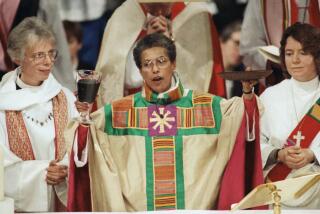Opinion: The pope’s latest decree is a victory for Catholic women

- Share via
A lot of American Catholics might not see the importance of Pope Francis’ declaration that women can take part in the formal ministries of acolyte and lector. After all, there have been “altar girls” in many American parishes for years.
But “many” is not “all.” Some parishes and dioceses allow only boys to assist the priest at the Mass and other ceremonies.
The pope’s decree doesn’t focus on children and adolescents or require that girls be allowed to serve Mass. It says that church law will be changed to say that “lay persons” of either sex may be formally installed in the ministries of acolyte (a priest’s assistant) and lector (a reader of Scripture during the liturgy). The church already allows people of either gender who are not acolytes to be altar servers.
Still, the pope’s decree sends a message to Catholic parishes and dioceses that allow only boys to serve Mass. It’s the same message that St. Paul preached to the Galatians: “There is no male and female, for you are all one in Christ Jesus.”
A “no girls allowed” policy is a often a sign that a parish is uncomfortable not only with including females in prominent roles in worship but also with larger changes in the church introduced in the aftermath of the Second Vatican Council of the 1960s. (Another tipoff is whether a parish offers the “Extraordinary Form” of the Mass — that is, the Latin Mass essentially as it was celebrated before Vatican II.)
Cardinal Raymond Burke, an American prelate who is a hero to traditionalists, sounded off about this subject in a 2015 interview with a representative of The New Emangelization Project. (That’s not a typo; the group tries to put the “man” in evangelization.)
Burke suggested that Catholic men are reluctant to get involved in the church because it has been “feminized.” He linked this phenomenon to the advent of altar girls.
“The introduction of girl servers also led many boys to abandon altar service,” Burke said. “Young boys don’t want to do things with girls. It’s just natural. The girls were also very good at altar service. So many boys drifted away over time.”
The cardinal also said that it requires a “certain manly discipline to serve as an altar boy in service at the side of a priest, and most priests have their first deep experiences of the liturgy as altar boys. If we are not training young men as altar boys, giving them an experience of serving God in the liturgy, we should not be surprised that vocations have fallen dramatically.”
That points to another feature of traditionalist Catholicism: an emphasis on the difference between priest and lay person, a commonplace in the pre-Vatican II church. Conservative Catholics are also alarmed by calls for the church to ordain women as priests or at least as deacons, who can preach and baptize but not celebrate Mass.
Against this backdrop, the pope’s action is significant. Francis explained that he was acting in response to “a doctrinal development” that “has highlighted how certain ministries instituted by the church are based on the common condition of being baptized and the royal priesthood received in the sacrament of Baptism.” So much for the notion that being an altar boy is a stepping-stone to the priesthood or the idea that serving Mass is a “manly” activity.
To be sure, Francis drew a distinction between ministries rooted in baptism and those, such as the priesthood, that are conferred by the sacrament of Holy Orders. Citing a 1994 pronouncement by the late Pope John Paul II, Francis has made it clear that the Catholic Church will not follow the example of the Episcopal Church by ordaining women as priests.
Even so, the pope’s decree means that Catholics who attend Mass will continue to see women playing significant roles in the church’s rituals, with altar girls wearing the same vestments as altar boys. In many Catholic parishes women also help to distribute the consecrated bread and wine of Holy Communion, a function once reserved to the clergy.
Despite what the pope may say, such optics will make some churchgoers wonder why women who are already performing various sacred duties can’t be priests.
In 1975 the late Raymond Brown, perhaps the foremost Catholic biblical scholar of his time, advocated that women be given a range of roles at Mass. He mentioned women serving as lectors and distributing Holy Communion and said that “younger girls” could serve at the altar. “When all of these things are done,” he wrote, “we may be in a better position to discuss intelligently the ordination of women priests.”
The practices Brown advocated have come to pass. Despite what John Paul II and Francis said, the agitation for ordaining women is likely to continue. If donning vestments makes altar boys visualize themselves as priests, that idea is also going to occur to some of the altar girls serving alongside them.
More to Read
A cure for the common opinion
Get thought-provoking perspectives with our weekly newsletter.
You may occasionally receive promotional content from the Los Angeles Times.











